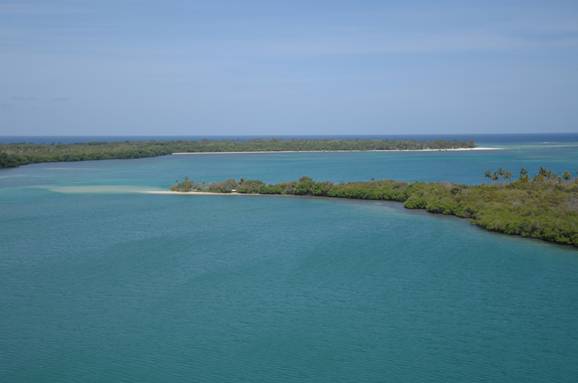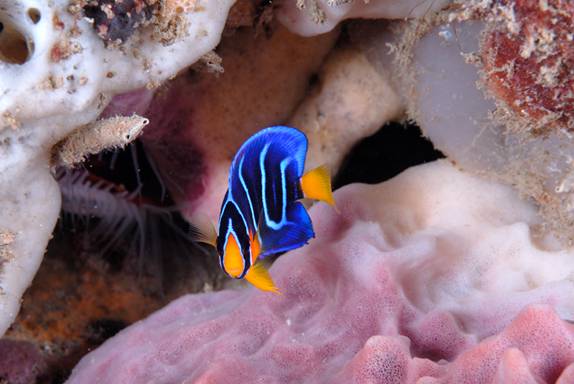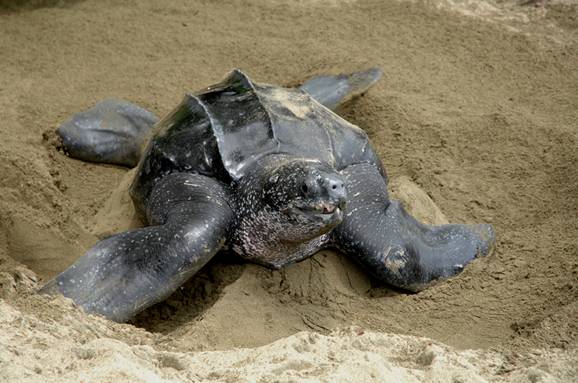BUCCOO REEF
From The Directorate of Sustainable Tourism
Tobago is the smaller of the two main islands that make up the Republic of Trinidad and Tobago. It is located in the Southern Caribbean Sea, Northeast of the island of Trinidad and Southeast of Grenada. One of the main attractions in Tobago is Bucco Reef .
In 1973, the area was declared a Marine Protected Area. The Institute of Marine Affairs with the assistance of the Tobago House of Assembly developed a management plan for the proposed Buccoo Reef Marine Park.
Buccoo Reef is one of the major reefs easily accessible to non-swimmers. The famous "Buccoo Reef" was visited by Jacques Cousteau, French Oceanographer and Explorer. He rated Tobago's Buccoo Reef as the number three spectacular sight to behold in the world. Most tourist facilities are located in the nearby villages of Buccoo and Bon Accord, as well as along the coast from Plymouth to Crown Point.
 All the known hard corals and most of the soft ones can be found around Tobago. Turtles - the endangered leatherback, the green loggerhead and the hawksbill all nest on beaches along Tobago's west coast. The promotion of the Buccoo Reef area as a major tourist attraction, combined with hotel and residential development in adjacent coastal areas, has resulted in direct and indirect impacts on the ecosystems.
All the known hard corals and most of the soft ones can be found around Tobago. Turtles - the endangered leatherback, the green loggerhead and the hawksbill all nest on beaches along Tobago's west coast. The promotion of the Buccoo Reef area as a major tourist attraction, combined with hotel and residential development in adjacent coastal areas, has resulted in direct and indirect impacts on the ecosystems.
From the Tobago House of Assembly
 What does “World’s Best Eco Destination” mean? This honour has been bestowed upon Tobago on 4 consecutive occasions between 2003 and 2006 by the World Travel Awards. The biodiversity of Tobago’s ecosystem was recognized as far back as 1776, when the Main Ridge Rainforest was declared a protected reserve.
What does “World’s Best Eco Destination” mean? This honour has been bestowed upon Tobago on 4 consecutive occasions between 2003 and 2006 by the World Travel Awards. The biodiversity of Tobago’s ecosystem was recognized as far back as 1776, when the Main Ridge Rainforest was declared a protected reserve.
The reef system surrounding the island is almost a mirror-image of the island’s terrestrial attributes and the Tobago House of Assembly – as do all Tobagonians – recognizes that this is critical to the continued success of Tobago as a tourist destination.
Certainly the high level of species endemic to the island has been sustained due to the approach to preserving the island’s natural history. The Department of Natural Resources & Environment has as its Mission the protection, preservation and enhancement of Tobago’s environment, as well as the promotion of the sustainable use and management of air, land, and water for the benefit of current and future generations.

From CABI : Look out for the Lionfish Invasion
 CABI is a not-for-profit international organization that improves lives by solving problems in agriculture and the environment.
CABI is a not-for-profit international organization that improves lives by solving problems in agriculture and the environment.
Look out for the Lionfish Invasion. Small islands reap tremendous rewards from their coral reefs. Tobago’s two largest industries; tourism and fishing, providing both jobs and food and are inextricably linked to the coral reefs of the island. Which also protect the coastline from erosion by breaking ocean swells. They also produce the sand on the beaches. One of the most common and enjoyable visitor attractions to Tobago is taking one of the many daily tours on the glass-bottom boats that allow a view of the reef from the comfort of the surface.
In 2008, Lauretta Burke and others concluded that the coral reef associated tourism contributes significantly to the economy of Tobago. They estimated that the “pull factor” of coral reef share in tourist arrivals was an estimated 40%. This corresponded to US$ of 43.5 million for 2006 alone. This positive contribution from Tobago’s reefs most notably the Buccoo Reef is currently being threatened by pollution the biggest culprit being untreated sewage. Runoff from the land that contains pesticides, fertilizers and other pollutants also continues to be a serious threat. Lurking in the waters of the Caribbean Sea is yet another serious threat: Invasive Alien Species (IAS). One such species is the lionfish.
The lionfish (Pterois volitans) is a coral reef fish from the tropical waters of the South Pacific and Indian Oceans. Now found in the western Atlantic Ocean, the most probable explanation for their arrival is via the Exotic Pet Fishes for Aquarium Trade. The lionfish is a nocturnal species and moves to deeper waters at night to forage. The species is relatively quick to adapt to a new prey. They are efficient carnivores that feed by devouring large numbers of a wide variety of smaller fishes, shrimps and crabs, out-competing native species. They also have the potential to decrease the abundance of ecologically important species such as the parrotfish and other herbivorous fishes that keep seaweeds and macro-algae from overcoming corals.
 Lionfish were first seen in 1985 in North Carolina, USA, in Bermuda in 2001, the Bahamas in 2004 and are now listed as a priority IAS in Jamaica. They have spread throughout the Bahamas and the northern Caribbean. The potential for loss to commercial fisheries and reef-based tourism as the Lionfish devours native species into extinction is severe. The Lionfish also possess venomous spines which are a serious threat to human health.
Lionfish were first seen in 1985 in North Carolina, USA, in Bermuda in 2001, the Bahamas in 2004 and are now listed as a priority IAS in Jamaica. They have spread throughout the Bahamas and the northern Caribbean. The potential for loss to commercial fisheries and reef-based tourism as the Lionfish devours native species into extinction is severe. The Lionfish also possess venomous spines which are a serious threat to human health.
Lionfish's venomous dorsal, anal and pelvic spines make them almost immune to predators. Current options to manage the lionfish's threat are limited. They are being removed individually at key locations through the training and licensing of diving professionals to respond to sightings. Groupers, a known natural predator of the lionfish, will be part of the natural control. A few lionfish have been found in the stomachs of native groupers in the Bahamas. If possible, you could help “protect a reef eat a lionfish” as the popular slogan in the Bahamas recommends.



